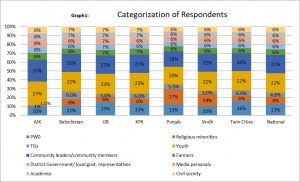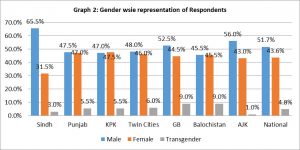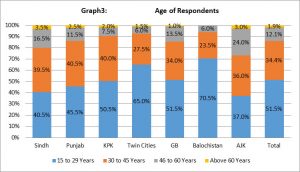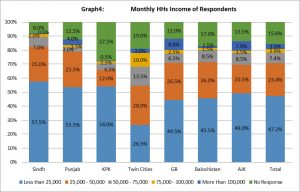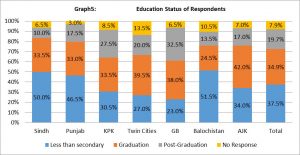The SDGs Citizens Scorecard is designed to document the perception of the citizens with regard to the progress on SDGs in Pakistan. This survey evaluates gaps and areas of improvement related to services of different social sector institutions as identified the general masses representing different geographical areas of Pakistan. This assessment also facilitates the process to identify the specific needs of the community to be considered at priority in the future interventions the state & society. The findings of the assessment further facilitate legislatures and policy makers to work on new legislations and policy level reforms required for the achievement of SDGs.
Scope of SDGs Citizens’ Scorecard
AwazCDS-Pakistan/ Pakistan Development Alliance have adopted consultative processes at different level for the designing of the SDGs Citizens’ Scorecard. These consultations provided very comprehensive and broad guidelines for defining the scope of the SDGs Citizens Scorecard questionnaire. In order to seek the guidance and support of various stakeholders and key experts, AwazCDS has formed a National Working Group (NWG) for the technical inputs which were required to determine the course of the scorecard. This working group was comprised of representatives from SDGs Unit- Planning Commission of Pakistan, Parliamentarians Commission for Human Rights (PCHR), and INGOs like VSO-Pakistan, & CBM – Christoffel –Blinde-Mission, Sightsavers and different alliances like SDGs Academy, Pakistan Coalition for Quality education (PCQE), Pakistan Development Alliance etc. (list of all working group members).
AwazCDS Pakistan has taken into consideration the targets under government’s National & Provincial Priority Frameworks, while developing the initial draft of the Citizens’ Scorecard. As per the guidelines of the National Priority Framework 02-03 targets are selected from each goal with the consultation of experts from National Working Group. All the questions of the SDGs Scorecard are designed in 04 dimensions as set the National Working Group around the factors related to Accessibility, Affordability, Quantity and Quality.
The detail of the selected SDGs and their respective targets are as below,
| Sr.# | SDGs Goal | Target |
| 1 | Goal 3: Good Health and Well Being
|
Target 3.1: Reduce the maternal mortality ratio |
| Target 3.2: End preventable deaths of newborns and children under age of 5 | ||
| Target 3.8: Coverage of Essential Health Services | ||
| 2 | Goal 4: Quality education
|
Target 4.5: Eliminate gender disparities in education and ensure equal access to all levels of education and vocational training for the vulnerable, including persons with disabilities, indigenous peoples and children in vulnerable situations |
| Target 4.a: Build and upgrade education facilities that are child, disability and gender sensitive and provide safe, non-violent, inclusive and effective learning environments for all | ||
| 3 | Goal 05: Gender Equality
|
Target 5.2: eliminate all forms of violence against all women and girls in public and private spheres, including trafficking and sexual and other types of exploitation |
| Target 5.3: Eliminate all harmful practices, such as child, early and forced marriage | ||
| Target 5.5: Ensure women’s full and effective participation and equal opportunities for leadership at all levels of decision-making in political, economic and public life | ||
| 4 | Goal 10: Reduce inequalities
|
Target 10.1: Progressively achieve and sustain income growth of the bottom 40 per cent of the population at a rate higher than the national average |
| Target 10.2: By 2030, empower and promote the social, economic and political inclusion of all, irrespective of age, sex, disability, race, ethnicity, origin, religion or economic or other status | ||
| Target 10.4: Adopt policies, especially fiscal, wage and social protection policies, and progressively achieve greater equality | ||
| 5 | Goal 16: Peace Justice and Strong Institutions | Target 16.1: Significantly reduce all forms of violence and related death rates everywhere |
| Target 16.3: Promote the rule of law at the national and international levels and ensure equal access to justice for all | ||
| Target 16.5: Substantially reduce corruption and bribery in all their forms | ||
| Target 16.6: Develop effective, accountable and transparent institutions at all levels | ||
| Target 16.7: Eensure responsive, inclusive, participatory and representative decision-making at all levels | ||
| Target 16.9: 2030, provide legal identity for all, including birth registration | ||
| Target 16.10: Ensure public access to information and protect fundamental freedoms, in accordance with national legislation and international agreements |
AwazCDS/ PDA National Secretariat team took the lead role in the development of 1st draft of the SDGs Citizens’ Scorecard which was further discussed and shared with the Pakistan Development Alliance Partners representing 14 selected Districts (Table A). After incorporating the feedback of the PDA member organization another national level meeting was organized with members of National Working Group to review and finalized SDGs Citizens Scorecard. National SDG Unit working under the aegis of Planning Commission of Pakistan and UNDP shared their precious inputs to improve questionnaire in the light of government perspective and set scopes of SDGs Scorecard. Sightsavers Pakistan shared their exquisite response in improving the questionnaire with the perspective and priorities of people living with disabilities. AwazCDS-Pakistan’s Umang program champions and Pakistan Coalition of Quality education (PCQE) gave their inputs regarding the girl’s right to quality secondary educations to improve goal 4 related questions. AwazCDS-Pakistan’s Ujala network contributed in the development of questionnaire as per the gender lens considering the selected targets under goal 05 and goal 10 and goal 16. Special consideration was also given to the needs of transgender community while developing the questionnaire around these goals and their selected targets. The questionnaire was also shared with the representatives of the SDGs National, Provincial and Regional Task Forces for their inputs before the launch. The final SDGs Citizens Scorecards (English Version & Urdu Versions) are available.
The results of the scorecard are reflected traffic lights as decided the National Working Group. Options are given against various questions considering the nature of questions.
- Green (Yes, on track/ Satisfied/ complete information/ understanding is there/ positive measures are taken)
- Yellow (Little bit information is available/ Somehow satisfied/ somehow people understand / few measures are taken)
- Red: (No information/ no understating/ unsatisfied/ no measures taken)
Respondents of the Scorecard:
An inclusive approach was adopted to record the responses of conveniently selected 1400 individuals @100 per district therefore special consideration was ensured for the gender balanced participation and representation of the marginalized groups i.e. PWDs, TGs and religious minorities. The respondents of the scorecards were further divided into different categories as per the below details considering gender parity i.e. 50% male and 50% females in the categories other than transgender community. Transgender representative were not categorized as he-males or she-males
- Youth (22 participants randomly selected from district – aged between 15-29 years
- People living with disabilities – 16 participants
- Religious minorities – Christians, Sikhs, Scheduled caste, Dalit etc.- 6 participants
- Community leaders’ /community members -20 participants –
- 06 Farmers, 06 District Governments/ local govt. representatives, 06 media personals, 06 academia, 06 transgender and 06 civil societies
Execution of Field Work:
The field work was executed in 14 selected districts following the convenient sampling method and 100 respondents per district were approached in person. The responses of the SDGs Scorecard are received up to the satisfaction level of team. Table A shares the details of the selected districts and organizations executed the field work.
| Sr.# | Name of the Organizations Executed the Field Work | District | # Scorecards filled |
| Islamabad Capital Territory | |||
| 1. | Minority Protection Trust | Islamabad | 100 |
| 2. | Society for Sustainable Development | Rawalpindi | 100 |
| Azad Jammu & Kashmir | |||
| 3. | Area Development organization | Muzaffarabad | 100 |
| 4. | Sustainable Development Organization | Mirpur | 100 |
| Balochistan | |||
| 5. | Water environment and Sanitation Society | Quetta | 100 |
| 6. | Waseela Development Organization | Ziarat | 100 |
| Gilgit Baltistan | |||
| 7. | Al Khidmat Foundation | Gilgit | 100 |
| 8. | Korakram Area Development Organization | Hunza | 100 |
| Khyber Pakhtunkhaw | |||
| 9. | Integrated Community Development Organization | Peshawar | 100 |
| 10. | Khpal Kore Organization | Mardan | 100 |
| Punjab | |||
| 11. | HomeNet Pakistan | Lahore | 100 |
| 12. | Neelab Children & Women Development Council | Rajanpur | 100 |
| Sindh | |||
| 13. | Legal Rights Forum | Karachi | 100 |
| 14. | District Development Association Tharparkar | Tharparkar | 100 |
| Total Questionnaires | 1400 | ||
Data Analysis:
AwazCDS/ Pakistan Development Alliance has engaged an expert data analyst for the analysis of the SDGs Citizens Scorecard. The dedicated team of the consultant has entered the data in CSPro software and the analysis was further carefully and critically reviewed the AwazCDS-Pakistan team along with the members of National Working Group members.
SDGs Citizens Scorecard Respondents –Analysis of Basic Information:
The provincial and regional representation of the survey respondents and their segregated data is categorized on the basis of gender, age, household income, and education level is depicted in the below graphs 1, 2, 3, 4 and 5 separately
Challenges and Limitations:
AwazCDS and its provincial and district partner organizations have made the scorecard field execution as thorough as possible and ensured all possible measures to minimize the risk of any unexpected hurdle. However, following were the challenges and limitations.
- In few Districts marginalized groups were not available i.e. Transgender community was not found in Ziarat and Hunza. Further to this religious minority was also not available in the whole district of Rajan Pur. In this scenario the target of Ziarat, Hunza and Rajan Pur was shifted to other district of the same province / region i.e. Quetta, Gilgit and Lahore respectively.
- Due to the limited funding of the program goals, targets, indicators and districts were selected considering the willingness, convenience and presence of partner organizations for the execution of citizens’ scorecard.
- Inter district and inter provincial/regional ranking and/or comparison was not possible in the SDGs ranking chapter because the scorecard methodology or execution was not designed for the said purpose. Only intra-provincial/regional and intra-district ranking of selected districts and provinces / regions were determined through the results of the citizens’ scorecard.

